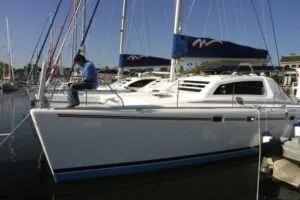For many sailors, selling their boats is an emotional experience. The big decision is setting the price. Setting your price, or the acceptable net monetary amount the sale will provide you, is very important if you want this to be a positive experience. However, getting the full asking price is rare, if not unheard of. You’ll need to make compromises, and you’ll undoubtedly feel a pinch.
I use the term “net monetary amount” because your initial desired selling price can be eroded in many ways, resulting in less money in your pocket. This is true whether you are selling directly or through a broker.
Time is the first consideration. Quantify the question: will a longer sales process result in more cost to you because of loan payments, approaching insurance renewal, mooring or dockage fees, and/or approaching end of season and, therefore, the need to haul out and arrange winter storage? Setting your price on the upper end of the market range for your model/year sailboat needs to consider these time-to-sell cost factors.
Setting your price needs to balance these costs against a shorter selling process versus a longer selling process. Where you set your price expectations versus the market will usually impact the time required to sell. Thinking ahead and determining the net amount you will have in your pocket if the sales process is protracted will help rationalize your asking price.

You can set the price on the high end of your sailboat’s market value and adjust down as buyer interest becomes established, but this is not a position of strength when trying to have buyers discover the value of your sailboat. A lot of buyers will simply wait out your next price reduction. A much better position is to price your sailboat realistically, which means marginally higher than your desired “net monetary amount.” But leave a small amount of room for a price reduction when dealing with a serious buyer who is making an offer. Always expect to sell lower than the initial asking price. Every purchaser likes to feel they exercised some control over the seller and got a “good” deal at a lower price than the asking amount.
Why are you selling your sailboat? Do you just need the money? Have you grown out of this sailboat and want a larger one? Are other life commitments getting in the way? Have your sailing years come to an end due to health or moving to the dark side (power boating)? Regardless, if you are selling directly versus using a broker, expect this question from potential buyers, and provide a credible, honest answer. Establishing some level of trust with a potential buyer is important during the sales process. A buyer will want to know if you’re selling because of some hidden defect, or a sincere interest on the seller’s part to trade up to another boat.
Know the market for your particular sailboat type, model, and year. What are the likely competing sailboats that are currently for sale? How many competing sailboats are for sale in your expected potential buyer geographic area? Depending on the value of your sailboat, the market area could cover a very considerable geographic range. A sailboat selling for $10,000 will have a localized market compared to a $100,000 sailboat. As sailboat value increases, it’s likely buyers will travel farther to see the boat. A sailboat worth hundreds of thousands can attract buyers from a considerable distance.

The more unique or up to date the sailboat is, the greater the applicable geographic range of potential buyers. If you are using a broker and the broker is not discussing these factors during the price-setting process, it will likely be best to find another broker. If you are going to sell direct, you will need to do some market research. Local broker listings, Yachtworld, Kijiji, and Facebook Market Place are all places to quickly establish the market asking price range for sailboats of your make and model. These boats will be competing for your buyer’s attention, so take a look at how competing listings compare with your photos, inventory list, and general condition.
Be honest with yourself as to what you are selling. Is it a fixer-upper (fondly referred to as a project boat), or has it been well maintained and lightly used? What does your sailboat need in terms of repairs or maintenance to allow the potential new owner years of enjoyment on the water? Is this a short simple list applicable to the DIY type? Or does the list include items like…re-powering, new standing rigging, substantial below-water line repairs? Cosmetic fiberglass repairs, cleaning, painting, upholstery upgrading, electronics upgrades are items that won’t scare away serious buyers. but diesel engine rebuild/replacements, new rigging (especially spar replacements) and keel/rudder repairs are items where most potential buyers will be very uncomfortable regarding the amount of work and associated costs.
What type of sailboat are you selling? Are you shedding the family daysailer? Or could it be equipped by a new owner as a competent weekender? Is your boat a racer, racer/cruiser, coastal cruiser, blue- water ocean crosser or even a long-term cruiser/liveaboard? Usually, a sailboat that has more than one possible function or use (racer/cruiser, cruiser/liveaboard) will have wider appeal. Same goes for production vs custom-built sailboats. The size of your sailboat will to a large extent determine what uses it could possibly be adapted to. Consider your sailboat’s construction material; wood, wood-epoxy, fiberglass, high-tech composites, aluminum, steel? This will impact your potential buyer’s interest. Fiberglass will have the widest appeal to the majority of potential buyers. Wooden sailboats certainly have a following but need to be recognized as requiring considerably more maintenance. High-tech composites and carbon fiber will usually be in the domain of performance cruisers or racing sailboats. Aluminum or steel will appeal to a smaller segment of potential buyers, usually blue-water long-distance cruisers.

Is your sailboat a monohull, catamaran or trimaran? Multihulls have existed for many years, but popularity has increased substantially in recent years, especially as long-term cruisers and liveaboards. There is always the possibility that the potential sailboat buyer is open to multihulls even though they initially were looking at monohulls. Another factor to consider with regard to the type of sailboat you are selling, is whether or not it is highway trailerable. This can be an important factor for some sailors depending on the desired use. Shallow draft, swing- or lifting-keel monohulls, and folding-ama trimarans can be very appealing to some potential buyers. While this will likely be a smaller segment of the potential buyers locally, the geographic area of interested buyers can be increased compared to a non-trailerable monohull, catamaran or trimaran.
How is your boat equipped given the current or potential uses? What is the age and condition of the equipment on board? If you have maintained your sailboat over a period of years you will have an appreciation for what maintenance costs. Same goes for upgrades to your sailboat. Your price should reflect what your spending has been, but don’t expect to recover all the money you have put into your sailboat, especially if you did not do the work yourself and hired others for the maintenance and upgrades.
Who built your sailboat? Some manufacturers have very good reputations and hold value very well. Other manufacturers have had their problems, and resale value reflects this. Research your sailboat manufacturer and the good, bad and ugly associated with the boat’s brand. If your sailboat is a custom build, was this built by a reputable builder or an amateur backyard builder? Custom builds usually will be less appealing and more difficult to insure.
What is the state of the overall economy and sailboat market? Sailboats are on the “want list” not the “need list,” so during weak economic periods the sailboat market will become more difficult, with more boats on the market and fewer buyers. Are you attempting to sell your sailboat during a buyer’s market or a seller’s market? Understanding this will affect your timing and your price.
MARKETING AND SELLING YOUR SAILBOAT
Regardless of whether or not you are using a broker, look for as many opportunities as possible to make your sailboat visible to potential buyers. Consider using Kijiji, Craigslist, Facebook Marketplace, local yacht club and marina bulletin boards, or sailboat websites allowing owner listings, like sailboatlistings.com, to name a few.

If you have owned the sailboat for some time, prepare a typed summary of major maintenance and upgrades in chronological order. Ideally with costs and supporting receipts.
Stage your sailboat for viewing by potential buyers. Make sure your sailboat is clean, neat and ideally, containing only what you are selling with the sailboat. This applies to whether your sailboat is in winter storage or in the water for sailing season. Personal items are easily identified to potential buyers and noted on an exclusion list if you are actively sailing your boat during the summer season. Prepare a written inventory list of equipment, sails, options and include the items on the excluded list.
If not using a broker and selling directly, be prepared to show your sailboat to potential buyers on their schedule. Get as many potential buyers on your sailboat as possible. There is a buyer out there for every sailboat. You just need to find that individual.
In most cases, a potential buyer will want to see the sailboat both out of the water and in the water. Be prepared to accommodate this need for serious buyers. Deciding on the time of year you choose to start the selling process will, of course, determine which happens first, out-of-the-water or in-the-water viewing by potential buyers. If at all feasible for you, start the selling process in early spring when you have a couple of months when your sailboat can be seen out of the water before your spring/summer launching. This will provide an opportunity for serious buyers to arrange an out-of-water survey inspection with minimum intervention required by you. Upon launching, a fully “dressed” inspection can be accomplished along with a professional survey and sea trial if a potential buyer chooses. Again, this timetable requires little additional effort by you, assuming you were going to launch the sailboat anyway. If at all feasible, it is recommended to have your sailboat in the water at least part of the sailing season to provide the best opportunity for a successful selling process and experience. This of course will not be possible if you are selling a fixer-upper that is not seaworthy at time of sale.
If your boat is seaworthy, getting a potential buyer out on the water on a nice sailing day without a surveyor onboard is the best way to move closer to an offer. It’s not unreasonable to ask for a deposit—10% of asking should be about right—in order to take the buyer on a sea trial. You can bank the deposit, but you need to make it refundable if the buyer’s sea trial or the buyer’s professional survey does not result in a sale. Typically, a seller can only keep a deposit absent a sale if the deal moves to a contract and the buyer backs out for whatever reason.
The offer will very likely be conditional on a survey, but the survey should always be at the buyer’s expense. Unless your sailboat is in near-perfect condition, expect the surveyor to find some items possibly requiring attention. You or your broker will need to agree on what these items are worth. In some cases, you may be able to simply address the item by lowering the price.

If an interested buyer is within reasonable sailing distance from your homeport, if at all possible, consider delivery of the sailboat to the buyer’s homeport. This can be a real benefit to some buyers who may not want to deliver the sailboat themselves or cannot find or afford a delivery captain. This gesture could help close a sale.
If your sailboat is over 30 years old, a new potential owner may have difficulty obtaining insurance. Talk to your insurance broker and get any advice and recommendation that could help a serious buyer who is having this difficulty.
If a potential buyer is using a broker as buyer’s agent, the selling process will likely be more complicated as you may not have much direct access to the actual buyer other than the time the buyer views the sailboat or during sea trials. When the time comes for direct access to the potential buyer, make the most of this access by asking questions that help gauge the potential buyer’s interest in your sailboat. This of course applies to a potential buyer with or without a buyer’s agent.
You may only get one shot at this opportunity, so quickly attempt to establish some level of trust by disclosing any items about your sailboat that might be missed by the buyer, but likely picked up by a surveyor. Ideally the surveyor should be finding very little that you have not already disclosed to the potential buyer. Once you have established some level of trust, you will more likely get honest answers with respect to the potential buyer’s motivation and level of interest in your sailboat. Some good questions are, how long has the potential buyer been looking for a sailboat and how many and what sailboats have they already looked at; do they currently have a sailboat that needs to be sold; what is the intended use and how well does your sailboat meet the potential buyer’s needs; what upgrades would be required, where is the potential buyer’s home port?
You have probably heard; the two best days of your life will be the day you bought your sailboat and the day you sold your sailboat. I like to think of the day you sold your sailboat as the day you are now free to purchase your next sailboat. A true sailor will never be happy without access to a sailboat. I wish you more happy days and memories aboard your next dream.
Hints, tips, tricks on closing the deal all welcome in the comments.



































